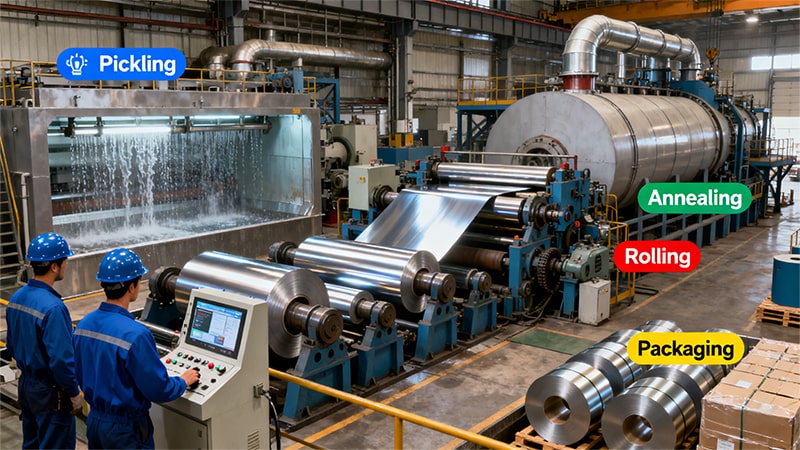
The production of tinplate demands rigorous technical controls at every stage of the process. From the early pickling stage to the final packaging, manufacturers must enforce strict standards to guarantee consistent quality, surface finish, and durability. Below is an overview of the essential requirements for each process, along with insights into why these standards matter for the global metal packaging industry.

Speed Control: Production speed must be carefully monitored to avoid under- or over-pickling.
Defect Monitoring: Operators inspect both sides of the coil for inclusions or pressed-in iron oxide, marking defects for traceability.
Surface Integrity: Scratches or edge damages are not tolerated.
Acid Removal: Residual acid is strictly prohibited, requiring clean rinse tanks and effective washing.
Incoming pickled material must be inspected thoroughly.
Flatness is critical—no mid-waves, rib waves, or severe edge waves are acceptable.
Yellow or black spots must be avoided, particularly at coil ends.
Common defects such as scratches, roller marks, and severe color variation are eliminated through stable, uninterrupted rolling.
Rolls must remain free of dents, scratches, or spiral marks.
Roughness should remain under 0.8, ensuring a smooth finish.
High-quality polishing increases surface brightness and uniformity.
Finished strips are measured with calipers to ensure correct width and minimal burrs.
Parking during cutting is reduced to keep coils uniform.
Defects like scratches, knife marks, or roller stains are carefully avoided.
Timely felt replacement minimizes carbon buildup on the surface.
Degreasing speed and current density are controlled to maintain surface cleanliness.
No water stains, electrode burns, or scratch defects are allowed.
Tension control ensures edges remain intact during annealing.
Specialized sleeves are mandatory to prevent deformation or coil damage.
Furnaces must operate within strict process parameters.
Coils under 0.25 mm thickness cannot exceed four rolls per 70-ton furnace load.
Special care prevents coil collisions during furnace loading and unloading.
Coil temperature must stay below 40°C during flattening.
Surfaces must remain free of roller marks, wrinkles, or edge creases.
Proper tension (≤5kg/mm²) and elongation (0.2–0.3%) ensure quality strip formation.
Internal standards require flatness without visible waves.
Roll pressure and alignment are adjusted to avoid distortions.
Micro-oil application at 80mg/m² ensures corrosion resistance.
Visual inspections at coil ends detect surface and shape issues early.
Elongation is maintained at 0.3–0.4%, never exceeding 0.5%.
Moisture-proof wrapping and protective corners are mandatory.
Coils must be handled gently with designated lifting devices.
Packaging ensures safe storage, transport, and delivery to customers worldwide.

| Production Stage | Key Technical Requirement | Quality Target |
|---|---|---|
| Pickling | Speed & acid control | No under/over pickling, no residual acid |
| Rolling | Flatness & color consistency | No waves, no roller marks, stable coil shape |
| Slitting | Precision cutting | Correct width, minimal burrs, no knife marks |
| Degreasing | Electrolytic cleaning | No stains, scratches, or residual oil |
| Annealing | Furnace load & heat control | No deformation, no coil collisions |
| Flattening | Tension & elongation control | Flat strip, elongation 0.2–0.3% |
| Leveling | Surface & oiling | No wrinkles, uniform elongation |
| Packaging | Protective wrapping | Moisture-proof, damage-free coils |
From a tinplate packaging manufacturer’s perspective, strict adherence to these standards is not only about quality assurance but also about market competitiveness. Premium tinplate serves as the backbone of industries such as food packaging, beverages, pharmaceuticals, and decorative cans. A single defect—be it surface scratches, poor flatness, or improper cleaning—can compromise print quality, sealing performance, and shelf appeal.
In today’s global supply chain, buyers demand tinplate that meets both aesthetic and functional expectations. Producers who maintain consistency across pickling, rolling, annealing, and packaging processes are better positioned to supply international brands, particularly in the fast-growing sustainable packaging sector, where tinplate is valued for its recyclability and protective performance.